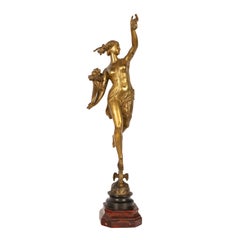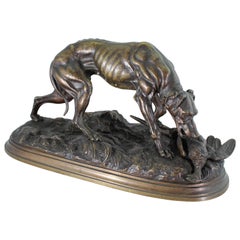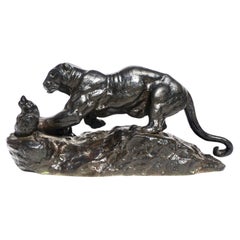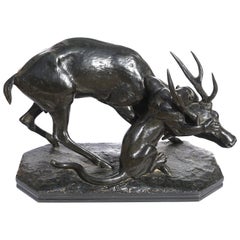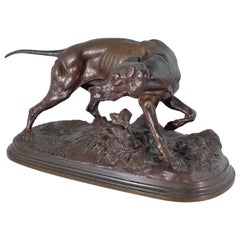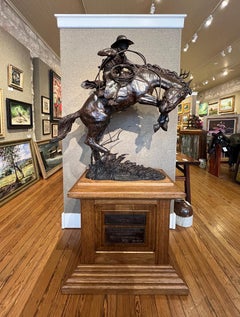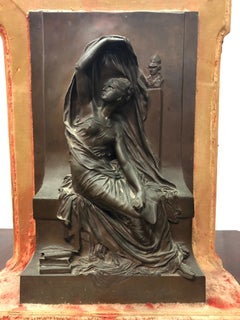1860s Figurative Sculptures
to
1
13
9
12
4
4
2
Overall Height
to
Overall Width
to
18
13
13
11
6
4
4
4
3
2
2
2
2
1
1
1
1
207
506
2,027
8,921
46
45
80
119
53
126
130
168
225
276
60
4
2
2
2
1
18
18
3
2
1
Period: 1860s
Antique French Gilt Bronze Marble Statue Sculpture of Fortuna Louis G Fulconis
Located in Portland, OR
A very good large antique French gilt bronze of the Roman goddess Fortuna, by Louis Guillaume Fulconis (1818-1873), circa 1860.
The bronze is inspired by sculpture of the Italian Ren...
Category
Renaissance 1860s Figurative Sculptures
Materials
Bronze
Jules Moigniez Bronze Sculpture of a Pointer and Pheasant, 19th Century
Located in Dallas, TX
Image of Jules Moigniez Bronze Sculpture of a Pointer and Pheasant, 19th Century
Jules Moigniez Bronze Sculpture of a Pointer and Pheasant, circ...
Category
1860s Figurative Sculptures
Materials
Bronze
Antoine Louis Barye Panther Attacking A Civet Cat
Located in Dallas, TX
ANTOINE-LOUIS BARYE (FRENCH, 1795-1875)
Panthère surprenant un zibeth, seconde version (Panther attacking a civet cat, second version)
signed BARYE
bronze, dark-brown patina with r...
Category
1860s Figurative Sculptures
Materials
Bronze
Antoine Louis Barye Bronze Panther Seizing A Stag, circa 1860
Located in Dallas, TX
Antoine-Louis Barye (FRENCH, 1795-1875)
Panthère saisissant un cerf (Panther seizing a stag)
Signed: “BARYE”
Stamped: Susse Fres
bronze, dark-green/black patina
Measures: Height ...
Category
1860s Figurative Sculptures
Materials
Bronze
Pierre Jules Mene Bronze, "Chien Braque a La Feuille"
Located in Dallas, TX
Pierre Jules Mene (French, 1810-1879)
Chien Braque a la Feuille
Bronze with brown patina
9.5 inches (24 cm) long
5 inches (12.7 cm) high
Inscribed on base: PJ Mene
Condition: ...
Category
1860s Figurative Sculptures
Materials
Bronze
Lion and snake
Located in PARIS, FR
Lion and snake n°3
by Antoine-Louis Barye (1796-1875)
Bronze sculpture with a nuanced dark greenish brown patina
signed "Barye" on the base
old edition cast – probably from the Bary...
Category
French School 1860s Figurative Sculptures
Materials
Bronze
L'Enfer des Luxurieux, The Hell of the Luxurious Relief, 19th Century Bronze.
Located in Stockholm, SE
A rare round relief cast, elaborate chiseled bronze/copper with brown patina by Jean François Marie Garnier (1820-1895). Cast c.1859-1864. Not signed. The motif is taken from Dantes...
Category
Symbolist 1860s Figurative Sculptures
Materials
Bronze
Young woman wearing a shawl
Located in PARIS, FR
Bust of a young woman wearing a shawl
by Albert-Ernest Carrier-Belleuse (1824-1887)
Terracotta bust
Raised on a in blackened wood pedestal
signed "A. Carrier "
France
circa 1860
total height 41 cm
width 24 cm
depth 17 cm
Biography :
Albert-Ernest Carrier de Belleuse known as Carrier-Belleuse (1824-1887) was one of the most prolific artists of the century and had the greatest successes under the Second Empire, enjoying the personal support of Napoleon III. His work was greatly influenced by the style of the Italian Renaissance and that of the 18th century, which he helped to bring up to date.
In 1837, the young Carrier-Belleuse apprenticed in the workshop of the engraver Bauchery. He was admitted soon after to the goldsmith Jacques Henri Fauconnier. Through François Arago, he met the sculptor David d'Angers who facilitated his admission to the School of Fine Arts. Carrier-Belleuse entered it in 1840. Noted for his skill by the great bronze companies in Paris such as Barbedienne and Denière, he soon received numerous orders for models for candelabras, pendulums, fittings for fireplaces, etc. In 1848, probably at the initiative of François Arago, who became head of state, he received his first public order for a small statue of "Mademoiselle Rachel singing La Marseillaise". In 1851, he appeared for the first time at the Salon of French Artists, where he presented two bronze medallions. From 1851 to 1855, Carrier-Belleuse stayed in England, in Stoke-on-Trent where he served as director of the modeling and drawing school of the Minton house, a large porcelain manufacturer.
Back in France, Carrier-Belleuse moved to Paris in a large workshop located 15 rue de la Tour d´Auvergne. From 1857, he made regular sendings to the Salon and became famous thanks to the success of large marbles, such as the "Bacchante" exhibited at the Salon in 1863, and acquired by Napoleon III, "Angelica" (1866) or even "Hebe asleep" (1869). At the Salon of 1867, his group entitled "Messiah" earned him the medal of honor of sculpture. It was acquired by the State to adorn the Chapel of the Virgin in the Saint-Vincent-de-Paul church.
Carrier-Belleuse acquired a great reputation in parallel for his terracotta busts which, in many respects, recall those of 18th century artists. He made portraits of a large number of celebrities of his time. He produced, among others, the busts of Napoleon III, Renan, Thiers, Grévy, Arago, Marguerite Bellanger, Théophile Gautier, Honoré Daumier, Delacroix, Hortense Schneider, Réjane… He also modelled numerous busts of mythological inspiration and historical and artistic portraits like Marie Stuart...
Category
French School 1860s Figurative Sculptures
Materials
Terracotta
Reclining Doe
Located in PARIS, FR
Reclining Doe
by Antoine-Louis Barye (1796-1875)
Bronze sculpture with a nuanced dark brown patina
signed "Barye" on the base
old edition cast – probably from the Barye's workshop (...
Category
French School 1860s Figurative Sculptures
Materials
Bronze
Antique: Mare Playing with a Terrier Dog (Good Companions) P. J. Mene 1860
Located in SANTA FE, NM
Antique Horse Bronze: Mare in the Stable Playing with a Dog (Good Companions)
Jument à l'écurie jouant avec un chien
Pierre-Jules Mene (French, 1810-1879)
Bronze
19 x 10 inches
One of Mene's most beloved bronze, well-loved early example with beautiful rich patina. A sensitive portrait of a horse nuzzling his companion while the terrier is giving kisses to the horse’s nose.
Cast by Mene’s own foundry and is very well detailed with a medium brown patina.
Pierre-Jules Mêne (1810-1879) was one of the most successful and prolific animalier sculptors of the 19th century, known for his naturalistic representation of animals.
Mêne received no formal education in sculpture but was taught to draw and model by his father and later began casting his own sculptures. He was largely self-taught, possessing a keen observation of nature that enabled him to capture the essence of his animal subjects with remarkable accuracy and vivacity.
His work debuted at the Paris Salon in 1838, and from that point onwards, he exhibited his sculptures regularly. Mêne specialized in small-scale domestic animals, his subjects often including horses, dogs, bulls, and sheep. Interestingly, almost no big game are found in Mêne's ouevre.
Beginning in 1837 as orders started coming in, Mêne worked as Antoine-Louis Barye before him, opening his own foundry where he personally oversaw the manufacture and production of his art. The work produced there bears the hallmark of extraordinary attention to detail and thoughtfulness shown in every element of presentation and assembly. His mastery in the technical aspects of casting bronze without relying on professional founders for the completion of his models gave him a significant advantage in producing his pieces with fine detail and at a lower cost. This operation was expanded in 1852 to handle the casting of models for his new son-in-law, Auguste Cain.
Mêne’s sculptures...
Category
Realist 1860s Figurative Sculptures
Materials
Bronze
Snake Charmer
Located in PARIS, FR
Bronze sculpture with a nuanced dark brown patina
signed on the base "A. Carrier"
inscribed on a front plaque "Charmeuse de Serpents par Carrier-Belleuse"
France
circa 1860
height 80,5 cm
Biography :
Albert-Ernest Carrier de Belleuse known as Carrier-Belleuse (1824-1887) was one of the most prolific artists of the century and had the greatest successes under the Second Empire, enjoying the personal support of Napoleon III. His work was greatly influenced by the style of the Italian Renaissance and that of the 18th century, which he helped to bring up to date.
In 1837, the young Carrier-Belleuse apprenticed in the workshop of the engraver Bauchery. He was admitted soon after to the goldsmith Jacques Henri Fauconnier. Through François Arago, he met the sculptor David d'Angers who facilitated his admission to the School of Fine Arts. Carrier-Belleuse entered it in 1840. Noted for his skill by the great bronze companies in Paris such as Barbedienne and Denière, he soon received numerous orders for models for candelabras, pendulums, fittings for fireplaces, etc. In 1848, probably at the initiative of François Arago, who became head of state, he received his first public order for a small statue of "Mademoiselle Rachel singing La Marseillaise". In 1851, he appeared for the first time at the Salon of French Artists, where he presented two bronze medallions. From 1851 to 1855, Carrier-Belleuse stayed in England, in Stoke-on-Trent where he served as director of the modeling and drawing school of the Minton house, a large porcelain manufacturer.
Back in France, Carrier-Belleuse moved to Paris in a large workshop located 15 rue de la Tour d´Auvergne. From 1857, he made regular sendings to the Salon and became famous thanks to the success of large marbles, such as the "Bacchante" exhibited at the Salon in 1863, and acquired by Napoleon III, "Angelica" (1866) or even "Hebe asleep" (1869). At the Salon of 1867, his group entitled "Messiah" earned him the medal of honor of sculpture. It was acquired by the State to adorn the Chapel of the Virgin in the Saint-Vincent-de-Paul church.
Carrier-Belleuse acquired a great reputation in parallel for his terracotta busts which, in many respects, recall those of 18th century artists. He made portraits of a large number of celebrities of his time. He produced, among others, the busts of Napoleon III, Renan, Thiers, Grévy, Arago, Marguerite Bellanger, Théophile Gautier, Honoré Daumier, Delacroix, Hortense Schneider, Réjane… He also modelled numerous busts of mythological inspiration and historical and artistic portraits like Marie Stuart, Shakespeare or even Mozart.
Carrier-Belleuse used and trained in his workshop in the rue de la Tour d´Auvergne many young talented artists such as Alexandre Falguière, Jules Desbois...
Category
French School 1860s Figurative Sculptures
Materials
Bronze
“Knife Wrestlers”, After The Statue By J. P. Molin, Stockholm 1867
Located in PARIS, FR
Rare and imposing reduction of the famous statue of JP Molin, inaugurated in 1867 in front of the National Museum of Stockholm.
This version in black enamelled stoneware was produced...
Category
Academic 1860s Figurative Sculptures
Materials
Sandstone
Carpeaux etnic bronze : Le chinois (1868). N1 (scetch) Observatory fountain
Located in Gent, VOV
JEAN-BAPTISTE CARPEAUX 1827 - 1875
Le Chinois N°1 (study for Asia) (1868). Model from the observatory fountain. Sketch
Height ca.60 cm
A similar copy auctioned on June 22, 2023, at ...
Category
Realist 1860s Figurative Sculptures
Materials
Bronze
Large 19th Century Antique Marble Bust of Apollo of Belvedere
By Pietro Bazzanti
Located in New York, NY
Pietro Bazzanti (1842-1881) specialized in allegorical and genre subjects as well as copies of Antique and Renaissance sculpture. Regarded as one of the most talented sculptors of h...
Category
Academic 1860s Figurative Sculptures
Materials
Marble
Antique Bronze Dog "Whippet with a Butterfly" Arthur Waagen (1833-1898) 2 of 2
Located in SANTA FE, NM
Antique Bronze Dog Portrait
“La Levrette au Papillon” or “Whippet (Greyhound) with a Butterfly”
Arthur Waagen (Germany, France 1833-1898)
Circa 1860’s
11 x 8 x 4 inches
(2of 2. No...
Category
Academic 1860s Figurative Sculptures
Materials
Bronze
Last Days of Napoleon in St-Helena
Located in Paris, FR
Vincenzo VELA (1820-1891)
Last Days of Napoleon in St-Helena
Created in 1866
Bronze with brown patina
Signed ‘V. Vela F. 1867’ on the terrace. Signed ‘F. Barbedienne Fondeur’. Stamp ...
Category
Realist 1860s Figurative Sculptures
Materials
Bronze
Antique Bronze Dog "Whippet with a Butterfly" Arthur Waagen (1833-1898) 1 of 2
Located in SANTA FE, NM
Antique Bronze Dog Portrait
“La Levrette au Papillon” or “Whippet (Greyhound) with a Butterfly”
Arthur Waagen (Germany, France 1833-1898)
Circa 1860’s
11 x 8 x 4 inches
(1 of 2. ...
Category
Academic 1860s Figurative Sculptures
Materials
Bronze
Le Rêve du Poète
Located in New York, NY
MATHURIN MOREAU
French, (1822-1912)
Le Rêve du Poète
Circa 1860, Patinated bronze; Signed ‘math moreau’ and Inscribed REVE DU POETE par MTH MOREAU, MEDAILL...
Category
1860s Figurative Sculptures
Materials
Bronze
Chien Braque (Tom)
Located in Missouri, MO
Pierre Jules Mene
"Chien Braque" (Tom)
Bronze
approx. 5 x 9 x 4.25
Signed
PIERRE JULES MENE (1810-1879)
Pierre Jules Mene, (P. J. Mene), was born in Pa...
Category
Realist 1860s Figurative Sculptures
Materials
Bronze
Avant Le Combat, Apres Le Combat
Located in New York, NY
ÉTIENNE-HENRI DUMAIGE
French, (1830-1888)
Avant Le Combat, Apres Le Combat
Pair of patinated bronze; signed 'H. Dumaige' and titled ‘AVANT LE COMBAT, APRÈS LE COMBAT, GRENADIER D...
Category
1860s Figurative Sculptures
Materials
Bronze
Bronze Figural Torchères and Pedestal - Médaille d'or - Exposition de 1867
Located in New York, NY
A. LACARRIÈRE PÈRE, FILS & CIE
French, (Mid 19th century)
Bronze Figural Torchères - Médaille d'or - Exposition de 1867
Monumental Patinated Bronze Figural Torchères on Pedestal; ...
Category
1860s Figurative Sculptures
Materials
Marble, Bronze
Life Mask of Abraham Lincoln
By Leonard Wells Volk
Located in London, GB
Leonard Wells Volk was a famous American sculptor. He went to posterity after making one of only two life masks of United States President Abraham Lincoln. I...
Category
Victorian 1860s Figurative Sculptures
Materials
Plaster
Related Items
" THE SPIRIT OF TEXAS " HUGE, 81" TALL BRONZE BUCKING BRONCO COWBOY WESTERN
By G. Harvey
Located in San Antonio, TX
G. Harvey (Gerald Harvey Jones)
(1933-2017)
San Antonio, Austin, and Fredericksburg Artist
Image Size: 81 Inches Tall
Medium: Bronze Sculpture
Dated 2006
"The Spirit Of Texas" Bucking Bronco & Rider
They are very scarce. I only know about 2 others that have
even come up for sale in the last 10 years or so.
Please not the dedication on the wooden base of the sculpture.
There is one on Gerald Harvey Jones (G. Harvey) tombstone in the Texas State Cemetery in Austin, Texas.
Western, Cowboy, Horse, Bronc, Bronco Riata, Rodeo
G. Harvey (Gerald Harvey Jones)
(1933-2017)
Known for paintings closely linked in mood and subject matter to Edouard Cortes [1882-1962], G Harvey creates romanticized street scenes of turn of the century towns in America. Rain slick streets reflect urban lights, and the weather is obviously cold. He grew up in the rugged hills north of San Antonio, Texas from where herds of longhorn cattle were once driven up dusty trails to the Kansas railheads. His grandfather was a trail boss at 18 and helped create an American legend for his grandson. So the American West is not only the artist's inspiration but his birthright.
Harvey's early interest in sketching and drawing slowly evolved into a passion for painting in oils. After graduating cum laude from North Texas State University, Harvey took a position with the University of Texas in Austin, but he soon realized that weekends and nights at the easel did not satisfy his love of painting. He abandoned the security of a full-time job in 1963 and threw his total energy into a fine art career. Harvey paints the spirit of America from its western hills and prairies to the commerce of its great cities. His original paintings and bronze sculptures are in the collections of major corporations, prestigious museums, the United States government, American presidents, governors, foreign leader and captains of industry. The Smithsonian Institution chose Harvey to paint The Smithsonian Dream, commemorating its 150th Anniversary. The Christmas Pageant of Peace commissioned Harvey to create a painting celebrating this national event. He has been the recipient of innumerable awards and the subject of three books.
G. Harvey lived in Fredericksburg, Texas, with his wife Pat in a 150-year-old stone home built by German settlers. His studio and residence are nestled within the Historic District of Fredericksburg. It is obligation of fine artists to present us with more than pretty pictures. They must also make us feel. Among the western painters of today, there is none more capable of accomplishing this than G. Harvey. In his paintings, the viewer into only sees the physical elements of his subject, but also senses the mood that surrounds them. It is a remarkable aspect of fine art, which few artists are able to master.
Gerald Harvey Jones was born in San Antonio, Texas, in 1933. His grandfather was a cowboy during the trail-driving era when legends grew up along the dusty trails north from Texas. Family stories of wild cattle and tough men were absorbed by a wide-eyed boy and became the genesis of G. Harvey's art. A graduate in fine arts at North Texas State University, Harvey taught full-time and painted nights and weekends for several years. It was through painting that he found his greatest satisfaction, and his native central Texas hill country provided the inspiration for most of his earliest work. With the development of his talent and the growth of his following, Harvey began to expand his artistic horizons. He left teaching and concentrated on a career in fine art. He sought the essence that is Texas and found it not only along the banks of the Guadalupe, but in cow camps west of the Pecos, and in the shadows of tall buildings in big Texas cities. The streets of Dallas once echoed with the sound of horse hooves and the jingle of spurs. Historic photographs reveal what it looked like, but only an artist like Harvey can enable a viewer to experience the mood and flavor or the time. Contemporary western art has too often centered on the literal representations from its roots in illustrations. Artists like G. Harvey take us a step further, to the subjective impressions that are unique to each great talent and which constitutes something special and basic to fine art expression.
Harvey was a soft-spoken and unassuming man who cared deeply about what he painted without becoming maudlin or melodramatic. We sense there is more in each Harvey painting than just that which is confined to the canvas.
Resources include: The American West: Legendary Artists of the Frontier, Dr. Rick Stewart, Hawthorne Publishing Company, 1986
Artist G. Harvey grew up in the rugged hills north of San Antonio, Texas from where herds of longhorn cattle were once driven up dusty trails to the Kansas railheads. His grandfather was a trail boss at 18 and helped create an American legend. The American West is not only the artist's inspiration but his birthright. Harvey's early interest in sketching and drawing slowly evolved into a passion for painting in oils. After graduation cum laude from North Texas State University, Harvey took a position with the University of Texas in Austin, but he soon realized that weekends and nights at the easel did not satisfy his love of painting. He abandoned the security of a full-time job in 1963 and threw his total energy into a fine art career. Two years as a struggling artist followed, but 1965 brought acclaim for the artist's first prestigious show, The Grand National exhibition in New York, and the American Artists' Professional League presented him with their New Master's Award. President Lyndon Johnson discovered his fellow Texan's talent, became a Harvey collector and introduced John Connally to the artist's work. Connally was enthusiastic about Harvey's art, and, on one occasion, he presented a G. Harvey original to each governor of Mexico's four northern states. Harvey paints the spirit of America from its western hills and prairies to the commerce of its great cities. His original paintings and bronze sculptures are in the collections of major corporations, prestigious museums, the United States government, American presidents, governors, foreign leader and captains of industry. The Smithsonian Institution chose Harvey to paint The Smithsonian Dream commemorating its 150th Anniversary. The Christmas Pageant of Peace commissioned Harvey to create a painting celebrating this national event. He has been the recipient of innumerable awards and the subject of three books. Through his art, our history lives.
Gerald Harvey Jones, better known as G. Harvey, grew up in the Texas Hill Country listening to his father and grandfather tell stories about ranch life, frontier days in Texas, and driving cattle across the Red River. Early in his career, he began to draw inspiration from that collective memory for paintings that would eventually earn him the reputation as one of America's most recognized and successful artists. His art is rooted in the scenic beauty of the land he grew up in and the staunch independence of the people who live there. He says, "My paintings have never been literal representations. They are part first-hand experience, and part dreams generated by those early stories I heard. They are a product of every place I have been, everything I have ever seen and heard." G. Harvey graduated from North Texas State University. He taught in Austin, but continued to study art in his spare time, eventually devoting full time to his painting. The year 1965 was a turning point when he won the prestigious New Masters Award in the American Artist Professional League Grand National Exhibition in New York. It is often said that in viewing a work of art, one is granted a unique look into the thoughts and expressions of values that give meaning to the artist work. Nowhere does this ring truer than the art of G. Harvey. Though Harvey has had nearly two decades of sell-out shows, an outstanding honor came with a series of one-man shows in Washington, D.C. in 1991. The first was at the National Archives featuring his paintings of the Civil War era, then a selection of paintings of notable Washington landmarks was exhibited at the Treasury Department, culminating in a one-man show of 35 paintings at the Smithsonian Institution during their exhibition of The All-American Horse. His work was featured in Gilcrease Museum exhibitions from 1992-1997. In 1987 his alma matter...
Category
Impressionist 1860s Figurative Sculptures
Materials
Bronze
H 82 in W 50 in D 25 in
Antique 19th cent. Dog Portrait Jack Russell Terrier by Pierre-Albert Laplanche
Located in SANTA FE, NM
Antique Bronze Dog Portrait of a Terrier
Pierre-Albert Laplanche (French, 1826-1873)
Signed in script to base "Laplanche"
Stamped "E.V 3753"
8 x 2.75 x 8 1/4 inches
This is a super...
Category
Academic 1860s Figurative Sculptures
Materials
Bronze
Terracotta figurativa italiana a tema mitologico dei primi del Novecento
Located in Florence, IT
Piccola terracotta a soggetto mitologico firmata sul retro sulla base "Zambini", che per la grafia (in particolare la Z che ricorda una F) permette di identificare l'artista con Ferr...
Category
Renaissance 1860s Figurative Sculptures
Materials
Terracotta
Ian Edwards - Leap Within Faith - Original Signed Bronze Sculpure
By Ian Edwards
Located in Collonge Bellerive, Geneve, CH
Ian Edwards - Leap Within Faith - Original Signed Bronze Sculpure
Dimensions: 170 x 55 x 40 cm
Edition of 12
Edwards’ practice expresses the power and determination of human endea...
Category
Contemporary 1860s Figurative Sculptures
Materials
Bronze
H 66.93 in W 21.66 in D 15.75 in
19th Century Pair of Hand-Carved Hall Chairs from Mexico
Located in Troy, NY
These 19th Century hand-carved hall chairs from Mexico are reminiscent of a Renaissance style in the design of the faces of the angels and ornamentation. This native wood is walnut colored with a stain that gives the chairs a caramel glow. The cushions are upholstered in a, light yellow silk brocade fabric. There are pin-sized holes from an earlier exposure to termites, a desirable element in antique Mexican furniture...
Category
Renaissance 1860s Figurative Sculptures
Materials
Fabric, Wood, Mixed Media
Antique French Grand Tour Gilt Bronze Statue on Column Diana the Huntress 1838
Located in Portland, OR
A fine & large (34" tall) antique French gilt-bronze on marble column of Diana, cast by Ferdinand Barbedienne (1810-1892) after a statue by Jean Antoine Houdon (1741-1828), the bronz...
Category
French School 1860s Figurative Sculptures
Materials
Marble, Bronze
A Flemish Statue of Crowned Virgin Mary with Child Jesus, 17th Century
Located in Bruges, BE
Description: A Flemish Statue of Crowned Virgin Mary with Child Jesus, 17th Century, polychromed wood, silver crowns
Statue: Crowned Madonna and Child
Object Type: Statuette
Artist, Sculptor / Creator: Unknown
Place of Origin: Flanders
Period: 17th Century
Style: Renaissance
Materials and Techniques: Polychromed wood, Silver
Categories: Christianity
Dimensions: H. 55 cm D. 15 cm W. 19 cm
History:
The Madonna and Child is one of the most easily recognisable, most frequently produced themes in the history of Art and has been depicted by many famous artists, including Michelangelo, Leonardo da Vinci, and Raphael.
The word Madonna is derived from the Italian 'ma donna,' or 'my lady' and is used to describe Mary, the mother of Christ.
The Madonna and Child depict a loving mother and son, which is a symbol of hope, faith, and love and represents the love and bond between mother and child, and is a symbol of hope and protection.
Purity or virginity is represented by the color of clothing of Madonna. The color blue symbolises purity, virginity, and royalty.
Physical Description:
A magnificent 17th Century statue in polychromed wood of standing Madonna and Child. Virgin Mary is holding a small staff that is often shown in the hands of a king or queen. In Her left arm She is holding Her Son, Jesus Christ who is holding the World in His left hand to show that He is our Heavenly king on Earth and His Mother is our Queen. She wears a tight fitting golden dress with blue sleeves; over this is a blue mantle; Her mantle is lined red and is with an ochre gold border. The flesh is painted in natural colours and Her long hair lies over both shoulders.
The Child Jesus wears a blue long sleeves dress...
Category
Renaissance 1860s Figurative Sculptures
Materials
Wood
H 21.66 in W 7.49 in D 5.91 in
Rabbit Little Prince PINKHAS Unique Piece Naive Art
Located in Tel Aviv - Jaffa, IL
Sculpture unique piece combining resin, acrylic, collages, and varnish by Pinkhas
Hand-signed on the side of the sculpture
Titled and dated under the sculpture
Perfect condition ...
Category
French School 1860s Figurative Sculptures
Materials
Resin, Varnish, Acrylic
Free Shipping
H 12.6 in W 5.52 in D 6.3 in
Antique Italian Grand Tour Bronze Marble Bust Sculpture Dante Alighieri 1880
Located in Portland, OR
A good antique Italian Grand Tour Bronze and marble bust of Dante Alighieri, circa 1880.
The bronze is most likely Florentine and mod...
Category
Italian School 1860s Figurative Sculptures
Materials
Marble, Bronze
H 16 in W 19 in D 9 in
Lion
Located in Oswestry, GB
This artwork is described beautifully by Art critic and curator Salvatore Russo at an exhibition in Uffizi Gallery, Florence 2016 - "Barry Davies, a sculp...
Category
Renaissance 1860s Figurative Sculptures
Materials
Bronze
Antique Silvered Bronze Rooster, France circa 19th Century
Located in SANTA FE, NM
Antique Silvered Bronze Rooster
France, circa 1900
10 1/4 x 9 1/2 (H x D) inches
A very fine and lively bronze statuette of a preening Rooster. Nicely cast and well-carved and in ex...
Category
French School 1860s Figurative Sculptures
Materials
Silver, Bronze
Antique Pair of Russian Wolf Hound/Borzoi Dog Portrait Sculptures circa 1930's
Located in SANTA FE, NM
Antique Pair of Russian Wolfhounds/Borzois Dog Portrait Sculptures
by Scalini (aka Scali; Italian, 20th century)
circa 1930's
Patinated spelter
9 x 14 inches (on bases)
Though rath...
Category
Art Deco 1860s Figurative Sculptures
Materials
Cast Stone, Bronze
Previously Available Items
Carpeaux etnic bronze : Le chinois (1868). N1 (scetch) Observatory fountain
Located in Gent, VOV
JEAN-BAPTISTE CARPEAUX 1827 - 1875
Le Chinois N°1 (study for Asia) (1868). Model from the observatory fountain. Sketch
Height ca.60 cm
A similar copy auctioned on June 22, 2023, at ...
Category
Realist 1860s Figurative Sculptures
Materials
Bronze
H 23.63 in W 17.72 in D 10.63 in
Henri Chapu Bronze Relief
Located in San Francisco, CA
Henri Chapu: 1833-1891. Well listed 19th century French sculptor. He has had auction results for bronze pieces as high as $45,000. This lovely bronze relief...
Category
Art Nouveau 1860s Figurative Sculptures
Materials
Bronze
Springtime
Located in PARIS, FR
Bronze sculpture with nuanced brown patina
Raisd on a gilt-bronze base
signed "A. Carrier"
France
circa 1860
total height 73 cm
Biography :
Albert-Ernest Carrier de Belleuse known as Carrier-Belleuse (1824-1887) was one of the most prolific artists of the century and had the greatest successes under the Second Empire, enjoying the personal support of Napoleon III. His work was greatly influenced by the style of the Italian Renaissance and that of the 18th century, which he helped to bring up to date.
In 1837, the young Carrier-Belleuse apprenticed in the workshop of the engraver Bauchery. He was admitted soon after to the goldsmith Jacques Henri Fauconnier. Through François Arago, he met the sculptor David d'Angers who facilitated his admission to the School of Fine Arts. Carrier-Belleuse entered it in 1840. Noted for his skill by the great bronze companies in Paris such as Barbedienne and Denière, he soon received numerous orders for models for candelabras, pendulums, fittings for fireplaces, etc. In 1848, probably at the initiative of François Arago, who became head of state, he received his first public order for a small statue of "Mademoiselle Rachel singing La Marseillaise". In 1851, he appeared for the first time at the Salon of French Artists, where he presented two bronze medallions. From 1851 to 1855, Carrier-Belleuse stayed in England, in Stoke-on-Trent where he served as director of the modeling and drawing school of the Minton house, a large porcelain manufacturer.
Back in France, Carrier-Belleuse moved to Paris in a large workshop located 15 rue de la Tour d´Auvergne. From 1857, he made regular sendings to the Salon and became famous thanks to the success of large marbles, such as the "Bacchante" exhibited at the Salon in 1863, and acquired by Napoleon III, "Angelica" (1866) or even "Hebe asleep" (1869). At the Salon of 1867, his group entitled "Messiah" earned him the medal of honor of sculpture. It was acquired by the State to adorn the Chapel of the Virgin in the Saint-Vincent-de-Paul church.
Carrier-Belleuse acquired a great reputation in parallel for his terracotta busts which, in many respects, recall those of 18th century artists. He made portraits of a large number of celebrities of his time. He produced, among others, the busts of Napoleon III, Renan, Thiers, Grévy, Arago, Marguerite Bellanger, Théophile Gautier, Honoré Daumier, Delacroix, Hortense Schneider, Réjane… He also modelled numerous busts of mythological inspiration and historical and artistic portraits like Marie Stuart, Shakespeare or even Mozart.
Carrier-Belleuse used and trained in his workshop in the rue de la Tour d´Auvergne many young talented artists such as Alexandre Falguière, Jules Desbois...
Category
French School 1860s Figurative Sculptures
Materials
Bronze
Le Monsieur qui ricane
Located in New York, NY
Bronze, modeled circa 1860 and cast later. Incised with the artist's initials and numbered 22/30. With the foundry mark Cire perdue Valsuani.
Published: Gobin, "Daumier Sculpteur, 1...
Category
Realist 1860s Figurative Sculptures
Materials
Bronze
Le Bourgeois qui flâne
Located in New York, NY
Bronze, modeled circa 1860 and cast later. Incised with the artist's initials and numbered 13/30. With the foundry mark Cire perdue Valsuani.
Published: Gobin, "Daumier Sculpteur, 1...
Category
Realist 1860s Figurative Sculptures
Materials
Bronze
La Défense Nationale by Gustave Doré
By Gustave Doré
Located in New York, NY
GUSTAVE DORÉ
French, (1832-1883)
La Défense Nationale
Patinated bronze; Signed G. Dore.
39 1/4 x 12 x 13 1/2 inches
Notes:
The patriotic soldier de...
Category
1860s Figurative Sculptures
Materials
Bronze
Marble Bust of a Beautiful Maiden
Located in West Sussex, GB
Holme Cardwell
(Active 1834 – 1895) British
Bust of a Beautiful Maiden
White marble sculpture. Signed, dated Holme Cardwell, Rome 1865.
Size: H:23 in W: 16in D: 8 in.
Born in Manc...
Category
Northern Renaissance 1860s Figurative Sculptures
Materials
Marble
French Orientalist Bronze Tunisian Water Carrier Sculpture by Jean-Didier Debut
By Marcel Debut
Located in Pasadena, CA
Jean-Didier Debut (1824-1893) - TUNISIAN WATER CARRIER ...
Bronze Sculpture; Debut (Jean Didier), after, Figure, Porteur d'Eau Tunisien, Water Carrier, 2...
Category
Romantic 1860s Figurative Sculptures
Materials
Bronze
H 25 in W 10 in D 10 in
“Enlevement des Sabines”
By Giambologna (Giovanni da Bologna)
Located in Southampton, NY
Here for your consideration is a beautiful highly detailed bronze done in the third quarter of the nineteen century after the work of Jean Boulogne, known as Giambologna. The bronze...
Category
Academic 1860s Figurative Sculptures
Materials
Bronze
Bronze Model of an Egyptian Dromedary Camel by Antoine-Louis Barye circa 1860's
Located in SANTA FE, NM
A Bronze Model of a Saddled Egyptian Dromedary Camel
Antoine-Louis Barye (French, 1795-1875)
circa 1860's
10 1/8 x 10 1/4 x 3 3/4 inches
Though Barye ...
Category
Romantic 1860s Figurative Sculptures
Materials
Bronze
Panthère de Tunis
Located in Paris, FR
Antoine-Louis Barye, 1796-1875
Panthère de Tunis, circa 1860
Bronze with brown patina
Signed ‘BARYE’. ‘BARBEDIENNE Fondeur’ cast.
Subject: 4" high x 10 1...
Category
1860s Figurative Sculptures
Materials
Bronze
Napoléon Bonaparte on Horseback
By Xavier Raphanel
Located in New York, NY
XAVIER RAPHANEL
French, (19th century)
Napoléon Bonaparte on Horseback
Patinated and gilt bronze; Signed ‘X Raphanel’ on base
24 x 16 inches
Notes:
B...
Category
1860s Figurative Sculptures
Materials
Bronze
